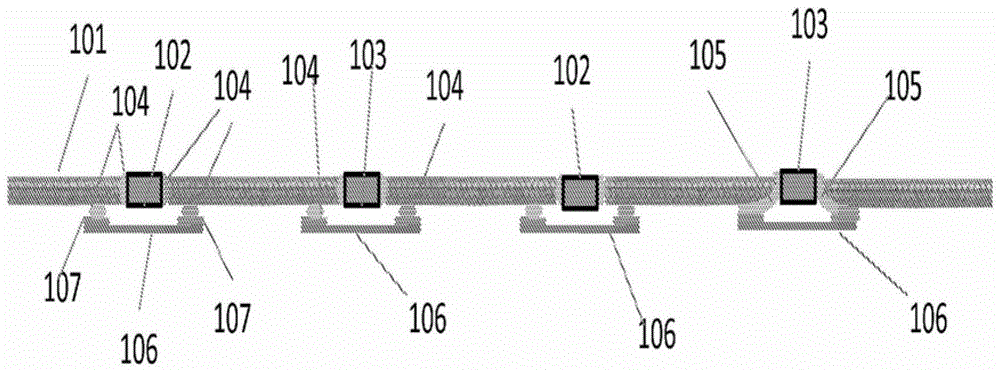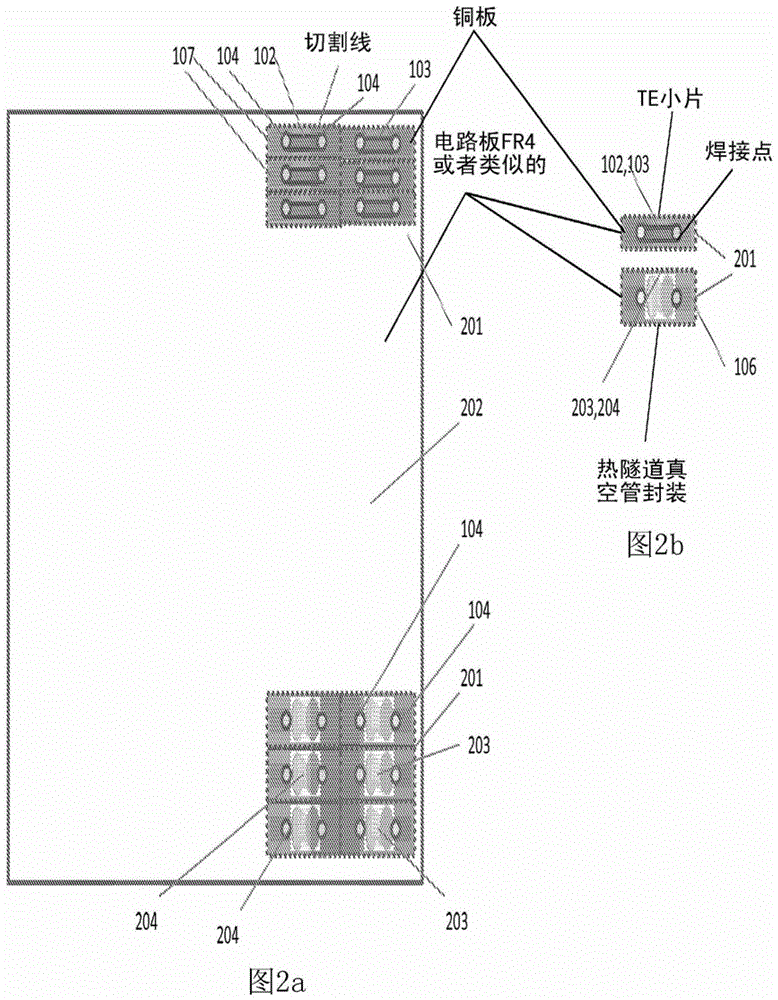Distributed thermoelectric stringers and insulation panels and applications for localized heating, localized cooling, and generation of electricity from heat
A stringer and circuit board technology, which is used in distributed thermoelectric stringer and insulation boards, as well as local heating, local cooling, and the application of heat to generate electric energy, can solve the problems of high capital start-up costs, low overall efficiency, and large temperature increments. , to eliminate the need for capillary action fluid, reduce energy consumption, and save costs
- Summary
- Abstract
- Description
- Claims
- Application Information
AI Technical Summary
Problems solved by technology
Method used
Image
Examples
Embodiment 1
[0069] Example 1: Thermoelectric cooler according to the invention
[0070] Figures 7a-7c A thermoelectric cooler 701 according to the invention is described. use as Figure 1a The strings shown build four thermoelectric panels 505 with strands 101 lengths of 7 and 11 cm on the cold and hot sides, respectively. The panels are 1" (2.54cm) thick Styrofoam TM 301, with holes of 3 mm diameter, and a platelet spacing of 3 cm. A total of 256 dies were inserted into the four assembled panels. The four thermoelectric panels are combined with two simple Styrofoam TM panels to construct small coolers. Figures 7a-7c The cooler 701 in does not contain a heat sink or fan, and is powered by 20 watts of electricity.
[0071] Will Figures 7a-7c compared to a prior art commercial cooler 702 comprising a prior art thermoelectric module 704 also having 256 dies, a prior art heat sink 706, and a prior art fan 705 . This commercial cooler design runs on 40 watts of electricity.
[007...
Embodiment 2
[0086] Example 2: Solar Energy Storage and Power Generation
[0087] according to Figure 9 Embodiments of the electrical generator of ® will now be described as being comparable to other electrical generators such as wind turbines and photovoltaic panels. The thermal storage medium 905 is 2m x 2m x 0.3m and is assumed to achieve a peak temperature of 100°C. This temperature does not exceed the boiling point of water and is a temperature easily reached by an insulated solar cooker used to cook food. Assume that the cold side 901 temperature is room temperature or 20°C. The temperature increment ΔΤ across the thermoelectric panel 902 was 80°C and the average temperature was 60°C. If the heat capacity of water is assumed to be 4.2 Joules / cm 3 °C, the heat storage medium can store 4.0E+8 joules or 112 kWh at a temperature rise of 80 °C relative to the environment.
[0088] The dimensions of the insulating material 903 are 2m x 2m x 0.05m, and if the typical thermal conductiv...
Embodiment 3
[0096] Example 3: Distributed Thermoelectric Mattress
[0097] Figure 10 show Figure 3c How the thermoelectric panels of the company are used to heat or cool the surface of a mattress with springs. The braided or stranded wires of the thermoelectric string 101 extend into the cavity of the mattress shell 151 . A fan 153 is used to remove heat from the materials or deliver heat towards the wires, depending on whether the mattress surface is to be heated or cooled. Because the heat is highly distributed by the present invention, the fan 153 can have a lower speed per second to reduce noise and power consumption. In some cases, a fan may not be needed at all if the mattress cavity is well ventilated by other means. The air flow 152 produced by the fan 153 appears to be somewhat resisted by the presence of the spring 154 . Vents 155 allow the air to diffuse from fan 153 to the environment.
[0098] Figure 11a with 11b A similar concept of an air mattress is shown. The ...
PUM
| Property | Measurement | Unit |
|---|---|---|
| Resistance | aaaaa | aaaaa |
Abstract
Description
Claims
Application Information
 Login to View More
Login to View More - R&D
- Intellectual Property
- Life Sciences
- Materials
- Tech Scout
- Unparalleled Data Quality
- Higher Quality Content
- 60% Fewer Hallucinations
Browse by: Latest US Patents, China's latest patents, Technical Efficacy Thesaurus, Application Domain, Technology Topic, Popular Technical Reports.
© 2025 PatSnap. All rights reserved.Legal|Privacy policy|Modern Slavery Act Transparency Statement|Sitemap|About US| Contact US: help@patsnap.com



